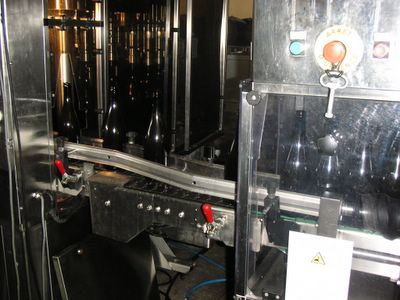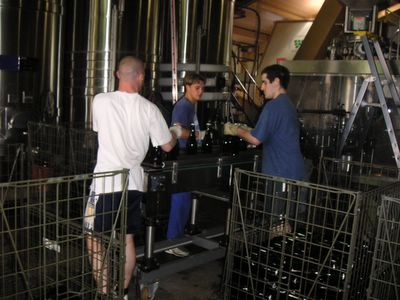The world famous vineyards of Champagne are as close as 150 kilometres east of Paris. Less than a daytrip really, when you live in a country as big as France.
Map
(Download PDF-file.)The area within the delimitation (the AOC) covers about 32.000 hectares... you will probably never see excactly the same number twice, because the number never really is stable. There will always be vineyards that are renewed, and at least theoretically will be empty three years.
On top of that add rarities such as the cemetary in Avize that is actually placed on soils that could be planted with vines. Even this until now has not made the villagers abolish their cemetery.
Three varieties of vines are dominant: The white grape
Chardonnay and the red grapes
Pinot Noir and
Meunier. Few old varieties such as
Petit Meslier and others can still be found, but they are few.
Each area has its characteristics:
Montagne de ReimsCôte des BlancsVallée de la MarneMassif de Saint-ThierryCôte des Bar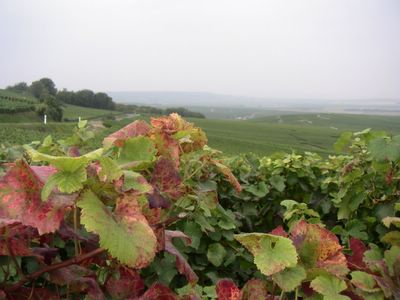 The mountainous landscape at the windmill of Mumm in the Montagne de Reims at Verzenay.Montagne de Reims
The mountainous landscape at the windmill of Mumm in the Montagne de Reims at Verzenay.Montagne de ReimsBetween rivers Marne and Vesle the plateau of
Montagne de Reims raises between 100 and 150 metres above the flat plains below, where Reims is on one side and Épernay on the other.
The ridge is 20 kilometres long from east to west and just about half from north to south. A big forest - the National Park of Montagne de Reims - covers most of the top. It is big enough to contain wild boar that at times have been seen close to our village but only early in the morning. At places the forest has been cleared to get land for at bit of vines and farming.
The rather savage forest has houses several abbeys, hermit's caves and worked as refuge for the inhabitants of the lowlands at wartime. This has been a ever returning phenomenon in Champagne, that has staged just about all big wars during the last 1000 years.
Den ret vilde skov har i sin tid rummet flere klostre, eneboerhuler og fungeret som tilflugtsted for lavlandets beboere i krigstid - et jævnligt tilbagevendende fænomen her i Champagne, der har lagt jord til stort set alle store krige de sidste 1000 år. Bjerget rummer også flere levn fra 1. verdenskrig, blandt andet en tysk udkigspost.
Begrænset romantikNordsidens landsbyer rummer i øvrigt meget lidt gammel romantik, når man ser bort fra de krogede gader, hvis plan - eller rettere mangel på plan - må være nogenlunde oprindelig. 1. Verdenskrigs granatnedslag fra skyttegravene i dalen og et allieret bombardement af Verzy i 2. verdenskrig har gjort kål på det meste af resten.
Op imod 40 af Verzys huse blev helt eller delvist ødelagt - formentlig også vores eget i og med en del af bjælkekonstruktionen på vores loft er gamle telefonpæle - byen må have været ganske ødelagt. 40 huse er trods alt omfattende i en landsby, der i dag rummer omkring 1000 indbyggere. Dengang må her have boet langt færre.
I dag dyrker 1899 vinbønder de 3.924 hektar, fordelt på 30.199 parceller, der er beplantet med vin i Montagne de Reims. Det svarer til en ottendedel af det samlede areal med vin i Champagne. En stor del af de tradionelt dyreste druer kommer herfra, idet hele ni af Champagnes 17 Grand Cru-landsbyer ligger i dette område. Også den næstbedste Premier Cru er godt repræsenteret.
Montagne de Reims hører også til de områder, hvor der har været dyrket vin længst. Vinstokkene i området er da også noget ældre end gennemsnittet i Champagne med hele 41 procent over 30 år mod 35 procent totalt set.
 Ballonfærd over Montagne de Reims i maj.
Ballonfærd over Montagne de Reims i maj.Af de i alt 1899 vinbønder er 1.091 autoriserede som såkaldte
récoltants-manipulants eller
récoltants-coopérateurs. Det betyder, at de må sælge champagne under eget navn. Et af kravene er, at vinbonden bruger mere end halvdelen af sin arbejdstid på vinen. 586 er selvstændige vinbønder uden andet erhverv, 999 har en desuden en yderligere aktivitet - som os - mens de sidste 312 tilhører en eller anden form for selskab.
Antallet af selvstændige er i øvrigt vokset ret betragteligt de sidste 10 år. I 1995 ekspederede 670 vinbønder 9,7 millioner flasker. Nu er tallet altså oppe på 1.091, sidste år solgte de 10,4 millioner flaske til blandt andre de mange englændere, belgiere og hollændere, der ruller igennem Verzy og andre landsbyers små, krogede gader.
Pinot Noir og ChardonnayKooperativer spiller en forholdsvis vigtig rolle, idet 761 vinbønder sender hele eller en del af deres høst til et af bjergets 15 af slagsen. Heraf er Mailly Champagne Grand Cru og kooperativet i Ambonnay de suverænt største. Knapt halvdelen af druehøsten (45 procent) bliver i øvrigt solgt videre til de store huse.
De har dog langt flere druer fra bjerget i deres
cuvéer i og med, at de også selv ejer jord. Langt fra alle foretager namedropping fra vejkanten men til dem, der gør, hører i hvert fald Veuve Clicquot, Ruinart, Roederer, Mumm, Bollinger, Henriot, Moët og Taittinger.
Rødvinsdruen Pinot Noir er den vigtigste type i Montagne de Reims, 56,5 procent af jorden er beplantet hermed. Chardonnay følger næst med cirka det halve (28,5 procent), den finder man især i Villers-Marmery og Trépail, det er interessant nok at smage champagner på ren Chardonnay herfra, for det har en helt anden karakter end tilsvarende champagner fra Blanc de Blancs. De sidste 14,9 procent af jorden er beplantet med Meunier. Tendensen gennem de sidste 15 år har været mere Chardonnay og mindre Meunier.
 Chardonnay-vin ved Villers-Marmery.
Chardonnay-vin ved Villers-Marmery.Montagne de Reims omfatter kommunerne: Ambonnay (G), Beaumont-sur-Vesle (G), Billy-le-Grand (P), Bouzy (G), Chigny-les-Roses (P), Louvois (G), Ludes (P), Mailly-Champagne (G), Montbré (P), Puisieulx (G), Rilly-la-Montagne (P), Sillery (G), Taissy (P), Tauxières (P), Trépail (P), Trois-Puts (P), Vaudemanges (P), Verzenay (G), Verzy (G), Villers-Allerand (P), Villers-Marmery (P). (G = Grand Cru, P = Premier Cru).
Verzy og Verzenay er blandt de 10 vigtigste vinkommuner i Champagne. Ikke overraskende, alene Verzenay - en landsby med omkring 1.000 indbyggere - kan opregne over 70 små og større, selvstændige champagnevirkesomheder.
Kort over
Montagne de Reims (Link til PDF-fil).
Top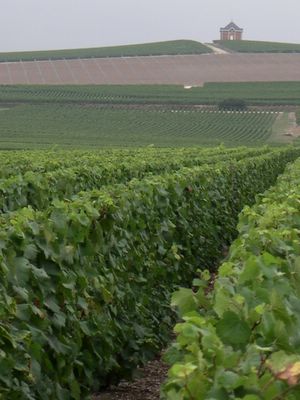 Lysthuset ved Cramant i Côte des Blancs.Côte des Blancs
Lysthuset ved Cramant i Côte des Blancs.Côte des BlancsCôte des Blancs' kerneområde er højdedraget, som begynder lige syd for Épernay og strækker sig over godt 20 kilometer frem til Bergères-les-Vertus. Undervejs ligger en perlerække af ældgamle landsbyer med for manges vedkommende lige så ældgamle traditioner for at dyrke vin: Oiry, Chouilly, Cramant, Avize, Oger, Le-Mesnil-sur-Oger, Vertus.
Toppen er ligesom Montagne de Reims top dækket af en ret stor skov - den huser også vildsvin - vinen spreder sig ned ad skråningerne. I alt 3.162 hektar, der er beplantet med først og fremmest Chardonnay. Denne hvide drue er den helt fremherskende i Côte des Blancs - deraf navnet - bare 2,3 procent er beplantet med Pinot Noir og 1,1 procent med Meunier.
Parcellerne bliver mindreI dag Côte des Blancs dyrker 2306 vinbønder gennemsnitligt 1,51 hektar. Tallet dækker dog over, at næsten 2/3 (64 procent) råder over mindre end en hektar. Hele 1428 har en anden aktivitet udover vinen. Bare 585 dyrker vin som hovedaktivitet, hvilket udover lyst hænger sammen med, at man skal have en vis mængde jord for at kunne leve af det.
Den gennemsnitlige størrelse på en parcel i Côte des Blancs er da også med sine 10,48
ares noget mindre end gennemsnittet i hele regionen, som er på 12,01
ares. Tendensen går imod yderligere opsplitning, hvilke hænger sammen med generationsskifte og at jordpriserne er så skyhøje, at det næppe i dag er muligt for nogen at købe søstre og/eller brødre ud.
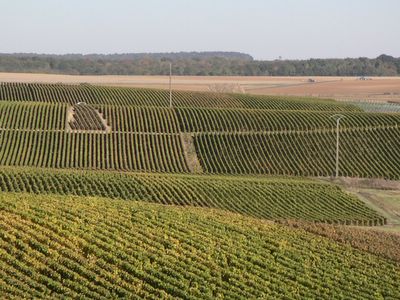 Parceller mellem Givry-les-Loisy og Soulières på den anden side af Vertus.
Parceller mellem Givry-les-Loisy og Soulières på den anden side af Vertus.Côte des Blancs er ligesom Montagne de Reims er meget gammelt vinområde. Det betyder for de ældste deles vedkommende - det er landsbyer som Avize, Cramant og Le-Mesnil-sur-Oger - at det klassificerede område er udnyttet stort set 100 procent.
I Avize har man således undladt at dyrke vin på kirkegården, der ellers er omfattet af den såkaldte delimitation og således godkendt til vindyrkning. Men det hører vist til en af de absolutte og meget lokale eksotismer.
Vinstokkene har for hele 46 procents vedkommende over 30 år på bagen, hvilket ingen alder er for en vin, der snildt klarer 50 år. Man overvejer først at skifte den ud, når den vitterligt ikke give nok druer længere eller de ikke længere har den fornødne kvalitet. Det er et både omfattende og dyrt arbejde at forny en hel vingård.
Tendensen er ligesom i Montagne de Reims at antallet af selvstændige, der sælger egen champagne fra eget hus, er voksende. Sidste år solgte 1392 firmaer således 8,7 millioner flasker, i 1970 solgte 428 firmaer 3,9 millioner flasker.
Stærk kooperativ tankeDen kooperative tanke er stærkt fremherskende i netop Côte des Blancs, hvilket uden tvivl hænger sammen med de mange små brug. Der skal trods alt både en vis mængde druer men selvfølgelig også lysten til at drive egen virksomhed til, før man begynder at sysle med egne etiketter.
 De store huses tankbiler henter stadig most hos La Vigneronne.
De store huses tankbiler henter stadig most hos La Vigneronne.I takt med, at det er blevet økonomisk mere attraktivt for vinbønder at dyrke druer i Champagne er man også begyndt at orientere sig mod at få en større bid af kagen selv. Hvilket bedst har kunnet lade sig gøre ved at slutte sig sammen i kooperativer, ikke mindst fordi mange - ligesom min svigermor - har haft almindeligt landsbrug at tage sig af udover vinen.
To kæmper tegner den overvejende del af kooperationen i Champagne. Det er Nicolas Feuillatte i Chouilly, hvis medlemmer tilsammen råder over mere end 2100 hektar, og ved Épernay og Union Champagne i Avize, der råder over 1200 hektar gennem sine medlemmer. Andre halvstore kooperativer i Côte des Blancs omfatter UPR i Le-Mesnil-sur-Oger og La Goutte d'Or og La Vigneronne i Vertus.
Sidstnævnte leverer vi selv druer til sammen med godt 230 andre. Den årlige produktion er omkring en million flasker. Da La Vigneronne åbnede i slutningen af 1950'erne var formålet primært at presse druer og sælge mosten videre til de store huse. I dag sælger man stadig most til blandt andre Lanson, men man går også hele vejen selv. Vi kunne således i november 2004 præsentere den første årgangschampagne af mærket Eustache Deschamps, forarbejdet af 100 procent Chardonnay fra Vertus.
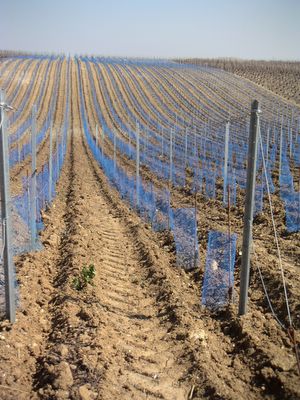 Nyplantet vingård i Côte des Blancs.
Nyplantet vingård i Côte des Blancs.Côte des Blancs omfatter kommunerne: Avize (G), Bergères-les-Vertus (P), Chouilly (G), Cramant (G), Cuis (P), Grauves (Chardonnay=P), Le Mesnil-sur-Oger (G), Oger (G), Oiry (G), Vertus (P), Villeneuve-Renneville (P) og Voipreux (P). (G = Grand Cru, P = Premier Cru).
Vertus, Chouilly og Le Mesnil-sur-Oger hører til de vigtigste vinkommuner i Côte des Blancs med henholdsvis 536, 510 og 429 hektar med vin.
Kort over
Côte des Blancs (Link til PDF-fil).
Top... fortsættes med:
Vallée de la MarneKort over
Vallée de la Marne (Link til PDF-fil).
Massif de Saint-ThierryKort over
Massif de Saint-Thierry (Link til PDF-fil).
Côte des BarKort over
Côte des Bar (Link til PDF-fil).
... når tiden og lysten tillader det... jeg gad nok vide, om der overhovedet er nogen, der når helt herned...
På danskCopyright: The copyright for text and photos at bobler.blogspot.com belongs to Solveig Tange. You may use my articles, photos or parts of them for non-commercial use and if I am credited as the author. Feel free to link to this site but not in your own frameset please.
 Special signs warn about lots of tractors during the grapeharvest. The effect may not be great since some of these signs are left all year round.
Special signs warn about lots of tractors during the grapeharvest. The effect may not be great since some of these signs are left all year round.















